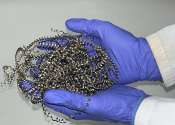'Golden' fossils reveal origins of exceptional preservation
All that glitters is not gold, or even fool's gold in the case of fossils.

All that glitters is not gold, or even fool's gold in the case of fossils.
Paleontology & Fossils
May 2, 2023
0
156

Researchers at MIT and elsewhere have developed a new combination of methods that can provide detailed information about the microstructure of polycrystalline metals.
Condensed Matter
Jul 6, 2016
0
1315

A UCLA research team has devised a technique that extends the capabilities of fluorescence microscopy, which allows scientists to precisely label parts of living cells and tissue with dyes that glow under special lighting. ...
General Physics
Nov 8, 2019
0
1217

Each time an item of clothing is washed up to 700,000 microscopic fibres make their way into our oceans, where they are swallowed by sea life and become incorporated into the food chain, potentially ending up on our plates, ...
Environment
Sep 13, 2018
0
114

The development of bimetallic nanoparticles (i.e., tiny particles composed of two different metals that exhibit several new and improved properties) represents a novel area of research with a wide range of potential applications. ...
Nanomaterials
Apr 24, 2020
0
1199

Physicists at the University of Basel have succeeded in watching a silver catalyst at work for the first time with the aid of an atomic force microscope. The observations made during an Ullmann reaction have allowed the researchers ...
Materials Science
Aug 17, 2016
0
1129

An extreme closeup of feathers from a bird with an uncanny ability to hold water while it flies could inspire the next generation of absorbent materials.
Plants & Animals
Apr 11, 2023
0
94

Phytoplankton need light and nutrients to grow. The microscopic algae rarely find both at the same time in sufficient quantities in the ocean. In the upper water layers, they usually lack nutrients, and further down, they ...
Earth Sciences
Aug 3, 2022
0
234

Scientists have found a way to transform metal waste into a highly efficient catalyst to make hydrogen from water, a discovery that could make hydrogen production more sustainable.
Analytical Chemistry
Apr 16, 2024
0
1078

Scientists have discovered several very rare species of microorganisms, some of which have never been seen before and others which have escaped the curious eyes of scientists for over a hundred years.
Ecology
Oct 1, 2022
0
95